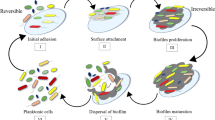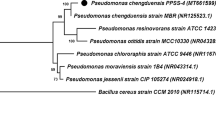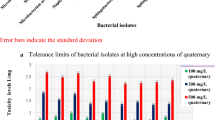Abstract
In the current study, six bacterial types, isolated from spent nuclear fuel (SNF) pool facility, were investigated for their ability to sequester heavy metals (cobalt and nickel). Biofilm formation by the six bacterial isolates, viz., Bacillus subtilis, Staphylococcus species, Staphylococcus arlettae, Staphylococcus epidermidis, Staphylococcus auricularis, and Chryseobacterium gleum, were assayed, and they were found to have significant biofilm forming property. Their biofilms were characterised using confocal scanning laser microscopy, and their potential to accumulate Co2+ and Ni2+ from bulk solutions was analysed with respect to time. A comparative assessment of bioaccumulation capacity was done using biofilms, planktonic cells, and live vs dead cells. The strains accumulated Co2+ and Ni2+ in the range of 4 × 10−4 to 1 × 10−5 g/mg of cell biomass. It is interesting to note that dead biomass also showed significant removal of the two metal ions, suggesting an alternative process for metal removal. This study suggests that hostile environments can be a repertoire of putative bacterial species with potential heavy metals and other contaminants remediation properties.







Similar content being viewed by others
Data availability
All data related to this study has been included in the manuscript.
References
Acharya T., & Hare J. (2022) Sabouraud agar and other fungal growth media. In: Gupta V.K., Tuohy M. (eds) Laboratory Protocols in Fungal Biology. Fungal Biology. Springer, Cham. https://doi.org/10.1007/978-3-030-83749-5_2
Banza, C. L. N., Nawrot, T. S., Haufroid, V., Decrée, S., De Putter, T., Smolders, E., Kabyla, B. I., Luboya, O. N., Ilunga, A. N., Mutombo, A. M., & Nemery, B. (2009). High human exposure to cobalt and other metals in Katanga, a mining area of the Democratic Republic of Congo. Environmental Research, 109(6), 745–752.
Barakat, M. A. (2011). New trends in removing heavy metals from industrial wastewater. Arabian Journal of Chemistry, 4(4), 361–377.
Benmalek, Y., & Fardeau, M. L. (2016). Isolation and characterization of metal-resistant bacterial strain from wastewater and evaluation of its capacity in metal-ions removal using living and dry bacterial cells. International Journal of Environment Science & Technology, 13, 2153–2162.
Bradl, H., Kim, C., Kramar, U., & StÜben, D. (2005). Chapter 2 Interactions of heavy metals. in: Interface science and technology, (Ed.) H.B. Bradl, 6, Elsevier, pp. 28–164.
Chandrangsu, P., Rensing, C., & Helmann, J. D. (2017). Metal homeostasis and resistance in bacteria. Nature Reviews. Microbiology, 15(6), 338–350.
Chicote, E., Moreno, D. A., Garcia, A. M., Sarro, M. I., Lorenzo, P. I., & Montero, F. (2004). Biofouling on the walls of a spent nuclear fuel pool with radioactive ultrapure water. Biofouling, 20(1), 35–42.
Chicote, E., Garcia, A. M., Moreno, D. A., Sarro, M. I., Lorenzo, P. I., & Montero, F. (2005). Isolation and identification of bacteria from spent nuclear fuel pools. Journal of Industrial Microbiology and Biotechnology, 32(4), 155–162.
Das, K. K., Reddy, R., Chandramouli, B., Ishwar, B., Das, S., Shrilaxmi, B. M., Lata, K., Jyoti, P., & Biradar, M. S. (2019). Primary concept of nickel toxicity – An overview. Journal of Basic and Clinical Physiology and Pharmacology, 30, 141–152. https://doi.org/10.1515/jbcpp-2017-0171
Diep, P., Mahadevan, R., & Yakunin, A. F. (2018). Heavy metal removal by bioaccumulation using genetically engineered microorganisms. Frontiers in Bioengineering and Biotechnology, 6, 157. https://doi.org/10.3389/fbioe.2018.00157
Diósi, G., Telegdi, J., Farkas, G., Gazsó, L. G., & Bokori, E. (2003). Corrosion influenced by biofilms during wet nuclear waste storage. International Biodeterioration & Biodegradation, 51(2), 151–156.
Ewing, R. C. (2015). Long-term storage of spent nuclear fuel. Nature Materials, 14(3), 252–257.
Farhan, S. N., & Khadom, A. A. (2015). Biosorption of heavy metals from aqueous solutions by Saccharomyces Cerevisiae. International Journal of Industrial Chemistry, 6(2), 119–130.
Gadd, G. M. (1990). Heavy metal accumulation by bacteria and other microorganisms. Experientia, 46(8), 834–840.
Giripunje, M. D., Fulke, A. B., & Meshram, P. U. (2015). Remediation techniques for heavy-metals contamination in lakes: A mini-review. CLEAN – Soil, Air, Water, 43(9), 1350–1354.
Gogada, R., Singh, S. S., Lunavat, S. K., et al. (2015). Engineered Deinococcus radiodurans R1 with NiCoT genes for bio-removal of trace cobalt from spent decontamination solutions of nuclear power reactors. Applied Microbiology and Biotechnology, 99, 9203–9213. https://doi.org/10.1007/s00253-015-6761-4
Gunathilake, C., Gorka, J., Dai, S., & Jaroniec, M. (2015). Amidoxime-modified mesoporous silica for uranium adsorption under seawater conditions. Journal of Materials Chemistry A, 3, 11650–11659.
Haque, M. M., Mosharaf, M. K., Haque, M. A., Tanvir, M. Z. H., & Alam, M. K. (2021). Biofilm formation, production of matrix compounds and biosorption of copper, nickel and lead by different bacterial strains. Frontiers in Microbiology, 12, 615113. https://doi.org/10.3389/fmicb.2021.615113
Haraguchi, H. (2004). Metallomics as integrated biometal science. Journal of Analytical Atomic Spectrometry, 19, 5–14. https://doi.org/10.1039/B308213J
Hansda, A., Kumar, V., & Anshumali. (2016). A comparative review towards potential of microbial cells for heavy metal removal with emphasis on biosorption and bioaccumulation. World Journal of Microbiology & Biotechnology, 32, 170. https://doi.org/10.1007/s11274-016-2117-1
Hebbeln, P., & Eitinger, T. (2004). Heterologous production and characterization of bacterial nickel/cobalt permeases. FEMS Microbiology Letters, 230(1), 129–135.
Heydorn, A., Nielsen, A. T., Hentzer, M., Sternberg, C., Givskov, M., Ersbøll, B. K., & Molin, S. (2000). Quantification of biofilm structures by the novel computer program COMSTAT. Microbiology (reading), 146, 2395–2407.
Igiri, B. E., Okoduwa, S. I. R., Idoko, G. O., Akabuogu, E. P., Adeyi, A. O., & Ejiogu, I. K. (2018). Toxicity and bioremediation of heavy metals contaminated ecosystem from tannery wastewater: A review. Journal of Toxicology, 2018, 2568038.
Jan, A. T., Azam, M., Siddiqui, K., Ali, A., Choi, I., & Haq, Q. M. R. (2015). Heavy metals and human health: Mechanistic insight into toxicity and counter defense system of antioxidants. International Journal of Molecular Sciences, 16(12), 29592–29630.
Karley, D., Shukla, S. K., & Rao, T. S. (2018). Isolation and characterization of culturable bacteria present in the spent nuclear fuel pool water. Environmental Science and Pollution Research, 25, 20518–20526. https://doi.org/10.1007/s11356-017-0376-5
Karley, D., Shukla, S. K., & Rao, T. S. (2019). Microbiota of spent nuclear fuel pool water with emphasis on their biofilm forming ability on stainless steel (SS-304L). Journal of Biosciences, 44(5), 108.
Karley, D., Shukla, S. K., & Rao, T. S. (2022). Microbiological assessment of spent nuclear fuel pools: An in-perspective review. Journal of Environmental Chemical Engineering, 10(4), 108050.
Karman, S. B., Diah, S. Z. M., & Gebeshuber, I. C. (2015). Raw materials synthesis from heavy metal industry effluents with bioremediation and phytomining: A biomimetic resource management approach. Advances in Materials Science and Engineering, 2015, 185071.
Kirsch, F., & Eitinger, T. (2014). Transport of nickel and cobalt ions into bacterial cells by S components of ECF transporters. BioMetals, 27(4), 653–660.
Koechler, S., Farasin, J., Cleiss-Arnold, J., & Arséne-Ploetze, F. (2015). Toxic metal resistance in biofilms: Diversity of microbial responses and their evolution. Research in Microbiology, 10, 764–773. https://doi.org/10.1016/j.resmic.2015.03.008
Kumar, V., Kumari, A., Pandey, M., & Sharma, M. (2022). Molecular mechanism of radio-resistance and heavy metal tolerance adaptation in microbes. In: Microbial extremozymes, novel sources and industrial applications, eds. M. Kuddus, Academic Press, ISBN 9780128229453, p. 275–293.
Leyssens, L., Vinck, B., Van Der Straeten, C., Wuyts, F., & Maes, L. (2017). Cobalt toxicity in humans—A review of the potential sources and systemic health effects. Toxicology, 387, 43–56.
Little, B., & Wagner, P. (2011). An overview of microbiologically influenced corrosion of metals and alloys used in the storage of nuclear wastes. Canadian Journal of Microbiology, 42, 367–374.
Majtan, T., Frerman, F. E., & Kraus, J. P. (2011). Effect of cobalt on Escherichia coli metabolism and metalloporphyrin formation. Biometals : An International Journal on the Role of Metal Ions in Biology, Biochemistry, and Medicine, 24(2), 335–347.
Martínez-Ruiz, E. B., & Martínez-Jerónimo, F. (2016). How do toxic metals affect harmful cyanobacteria? An integrative study with a toxigenic strain of Microcystis aeruginosa exposed to nickel stress. Ecotoxicology and Environmental Safety, 133, 36–46.
Monachese, M., Burton, J. P., & Reid, G. (2012). Bioremediation and tolerance of humans to heavy metals through microbial processes: A potential role for probiotics? Applied and Environmental Microbiology, 78(18), 6397–6404.
Mosharaf, M. K., Tanvir, M. Z. H., Haque, M. M., Haque, M. A., Khan, M. A. A., Molla, A. H., Alam, M. Z., Islam, M. S., & Talukder, M. R. (2018). Metal adapted bacteria isolated from wastewaters produce biofilms by expressing proteinaceous curli fimbriae and cellulose nanofibers. Frontiers in Microbiology, 9, 1334. https://doi.org/10.3389/fmicb.2018.01334
Muñoz, A. J., Espínola, F., Moya, M., & Ruiz, E. (2015). Biosorption of Pb(II) ions by Klebsiella sp. 3S1 isolated from a wastewater treatment plant: Kinetics and mechanisms studies. BioMed Research International, 2015, 719060.
Muralikrishna, I. V., & Manickam, V. (2017). Chapter twelve - Wastewater treatment technologies. In I. V. Muralikrishna, & V. Manickam (Eds.), Environmental Management. Butterworth-Heinemann (pp. 249–293).
Nies, D. H. (1992). Resistance to cadmium, cobalt, zinc, and nickel in microbes. Plasmid, 27(1), 17–28.
Nocelli, N., Bogino, P. C., Banchio, E., & Giordano, W. (2016). Roles of extracellular polysaccharides and biofilm formation in heavy metal resistance of rhizobia. Materials, 9, 418. https://doi.org/10.3390/ma9060418
Pal, A., Wauters, G., & Paul, A. K. (2007). Nickel tolerance and accumulation by bacteria from rhizosphere of nickel hyperaccumulators in serpentine soil ecosystem of Andaman, India. Plant and Soil, 293(1), 37–48.
Rajeev, M., Sushmitha, T. J., Toleti, S. R., & Pandian, S. K. (2020). Sediment-associated bacterial community and predictive functionalities are influenced by choice of 16S ribosomal RNA hypervariable region(s): An amplicon-based diversity study. Genomics, 112, 4968–4979.
Rajeev, M., Sushmitha, T. J., Aravindraja, C., Subba Rao, T., & Pandian, S. K. (2021). Exploring the impacts of heavy metals on spatial variations of sediment-associated bacterial communities. Ecotoxicology and Environmental Safety, 209, 111808. https://doi.org/10.1016/j.ecoenv.2020.111808
Rao, T. S. (2020). Mini review: Bacterial biofilms and implant infections: A perspective. Archives of Orthopaedics, 1(4), 98–105.
Sayqal, A., & Ahmed, O. B. (2021). Advances in heavy metal bioremediation: An overview. Applied Bionics and Biomechanics, 2021, 1609149. https://doi.org/10.1155/2021/1609149
Shukla, S. K., & Rao, T. S. (2013). Effect of calcium on Staphylococcus aureus biofilm architecture: A confocal laser scanning microscopic study. Colloids and Surfaces. b, Biointerfaces, 103, 448–454.
Shukla, S. K., & Rao, T. S. (2017). An improved crystal violet assay for biofilm quantification in 96-well microtitre plate. BioRxiv, 100214.
Shukla, S. K., Khan, A., & Rao, T. S. (2021). Biofilm extracellular polymeric substances-based bioremediation of radionuclides. In Microbial and Natural Macromolecules (pp. 751–773). Elsevier: Amsterdam, The Netherlands.
Singh, R., Gautam, N., Mishra, A., & Gupta, R. (2011). Heavy metals and living systems: An overview. Indian Journal of Pharmacology, 43(3), 246–253.
Songa, M., Kim, C.-L., & Kessel, D. S. (2018). Consideration of spent fuel pool island as an interim management option of spent nuclear fuel for Kori unit 3 & 4 during decommissioning of Kori site. Energy Strategy Reviews, 21, 163–171.
Sun, Z., Gong, C., Ren, J., Zhang, X., Wang, G., Liu, Y., Ren, Y., Zhao, Y., Yu, Q., Wang, Y., & Hou, J. (2020). Toxicity of nickel and cobalt in Japanese flounder. Environmental Pollution, 263, 114516.
Tchounwou, P. B., Yedjou, C. G., Patlolla, A. K., & Sutton, D. J. (2012). Heavy metals toxicity and the environment. EXS, 101, 133–164.
Teitzel, G. M., & Parsek, M. R. (2003). Heavy metal resistance of biofilm and planktonic Pseudomonas aeruginosa. Applied and Environment Microbiology, 69, 2313–2320. https://doi.org/10.1128/AEM.69.4.2313-2320.2003
Timková, I., Sedláková-Kaduková, J., & Pristaš, P. (2018). Biosorption and bioaccumulation abilities of Actinomycetes/Streptomycetes isolated from metal contaminated sites. Separations, 5(4), 54. https://doi.org/10.3390/separations5040054
Tomova, I., Stoilova-Disheva, M., Lazarkevich, I., & Vasileva-Tonkova, E. (2015). Antimicrobial activity and resistance to heavy metals and antibiotics of heterotrophic bacteria isolated from sediment and soil samples collected from two Antarctic islands. Frontiers in Life Science, 8(4), 348–357.
Valentine, N. B., Bolton, H., Kingsley, M. T., Drake, G. R., Balkwill, D. L., & Plymale, A. E. (1996). Biosorption of cadmium, cobalt, nickel, and strontium by a Bacillus simplex strain isolated from the vadose zone. Journal of Industrial Microbiology, 16(3), 189–196.
van Hullebusch, E. D., Zandvoor, M. H., & Lens, P. N. L. (2003). Metal immobilization by biofilms: Mechanisms and analytical tools. Reviews in Environmental Science & Biotechnology, 2, 9–33. https://doi.org/10.1023/B:RESB.0000022995.48330.55
Verotta, D., Haagensen, J., Spormann, A. M., & Yang, K. (2017). Mathematical modeling of biofilm structures using COMSTAT data. Computational and Mathematical Methods in Medicine, 2017, 7246286.
Wang, Z., Yeung, K. W. Y., Zhou, G., Yung, M. N., Schlekat, C. E., Garman, E. R., Gissi, F., Stauber, J. L., Middleton, E. T., Wang, Y. L., & Leung, K. M. Y. (2020). Acute and chronic toxicity of nickel on freshwater and marine tropical aquatic organisms. Ecotoxicology and Environmental Safety, 206, 111373. https://doi.org/10.1016/j.ecoenv.2020.111373
Zambelli, B., Uversky, V.N., & Ciurli, S. (2016). Nickel impact on human health: An intrinsic disorder perspective. Biochimica et Biophysica Acta (BBA) - Proteins and Proteomics, 1864(12), 1714–1731.
Zhao, M., Xu, Y., Zhang, C., Rong, H., & Zeng, G. (2016). New trends in removing heavy metals from wastewater. Applied Microbiology and Biotechnology, 100, 6509–6518. https://doi.org/10.1007/s00253-016-7646-x
Author information
Authors and Affiliations
Contributions
Dugeshwar Karley: involved in designing and conducting the experiments, data analysis, and in drafting the manuscript. Sudhir Kumar Shukla: conceived and designed the experiments, did the data analysis, and drafted the manuscript. Toleti Subba Rao: conceived and designed the experiments, data discussion, and finalised the manuscript.
Corresponding author
Ethics declarations
Competing interests
The authors declare no competing interests.
Additional information
Publisher's Note
Springer Nature remains neutral with regard to jurisdictional claims in published maps and institutional affiliations.
Supplementary Information
Below is the link to the electronic supplementary material.
Rights and permissions
Springer Nature or its licensor (e.g. a society or other partner) holds exclusive rights to this article under a publishing agreement with the author(s) or other rightsholder(s); author self-archiving of the accepted manuscript version of this article is solely governed by the terms of such publishing agreement and applicable law.
About this article
Cite this article
Karley, D., Shukla, S.K. & Rao, T.S. Sequestration of cobalt and nickel by biofilm forming bacteria isolated from spent nuclear fuel pool water. Environ Monit Assess 195, 699 (2023). https://doi.org/10.1007/s10661-023-11266-x
Received:
Accepted:
Published:
DOI: https://doi.org/10.1007/s10661-023-11266-x




